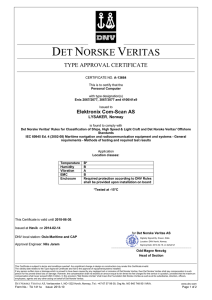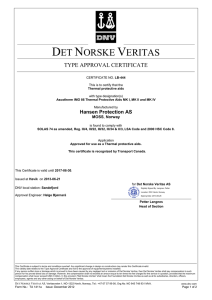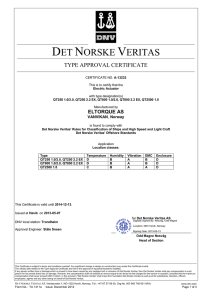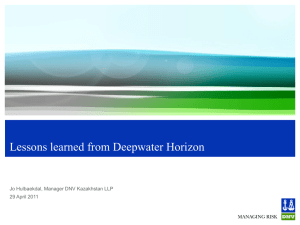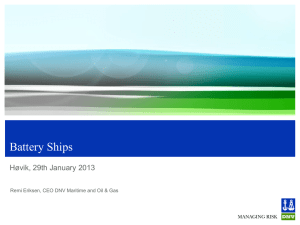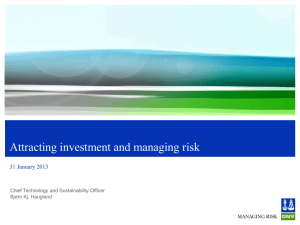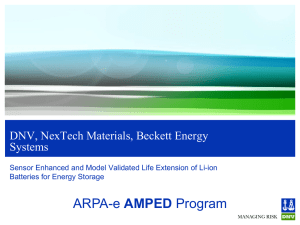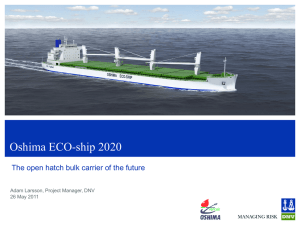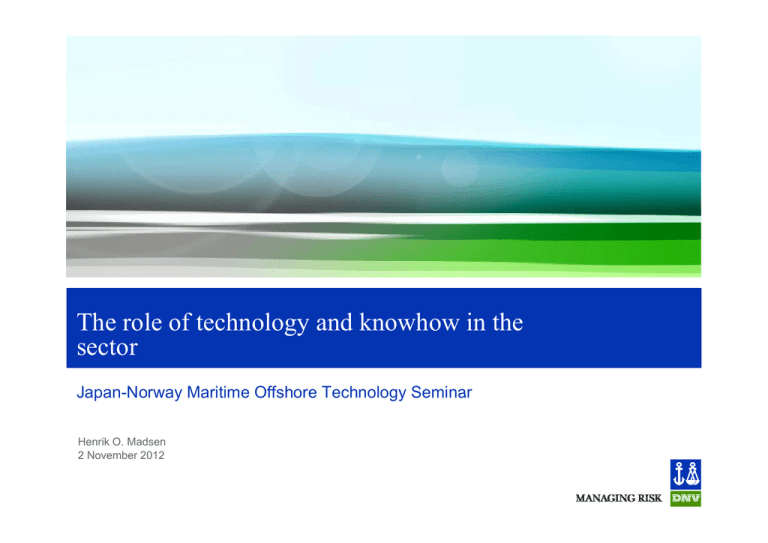
The role of technology
gy and knowhow in the
sector
Japan-Norway
Japan
Norway Maritime Offshore Technology Seminar
Henrik O. Madsen
2 November 2012
Numerous drivers for new and improved technology in the
Maritime Offshore sector…
Developments in the Arctic
- Exploitation of fisheries, oil and gas, and
rare-earth minerals
- Significantly reduce the distance between
Asia and Europe
- Increased volume of tourist traffic
Maximum exploitation of existing
equipment in new technology settings
Increased safety following Deepwater
Horizon
Deeper operations
Challenging reservoirs and well control;
High pressure high temperature,
deepwater
More sub sea intervention
The role of technology and knowhow in the sector
2 November 2012
© Det Norske Veritas AS. All rights reserved.
2
Numerous drivers for new and improved technology in the
Maritime Offshore sector
Offshore wind
Reducing local and global air pollution
and emissions, with related
regulations
Floating LNG
Better energy efficient operation
Trade patterns sho
show global impact
The role of technology and knowhow in the sector
2 November 2012
© Det Norske Veritas AS. All rights reserved.
3
The Arctic -Winterization needed due to cold climate
Vessels and rigs need to be winterized for safe
and reliable operation in cold climate
- Low air temperature Æ brittle materials
- Sea spray icing Æ equipment & systems malfunction
WINTERIZATION CLASS
Material requirements
Two engine rooms
Helicopter landing facilities
Life
Lif saving
i and
d navigation
i ti equipment
i
t
RESEARCH AND DEVELOPMENT
DNV is developing numerical models and science
based guidelines for sea spray icing
The role of technology and knowhow in the sector
2 November 2012
© Det Norske Veritas AS. All rights reserved.
4
The Arctic -Ice management
g
vessels
Drilling operations in ice needs to be supported with highly specialized multipurpose ice management vessels capable of:
-
Evacuation and rescue of personnel
Ice breaking
Supply operations
Oil spill response
The role of technology and knowhow in the sector
2 November 2012
© Det Norske Veritas AS. All rights reserved.
5
Jack-ups
p for Norwegian
g sector
Most of the current drilling plants on fixed installations
are old and worn out (>20 years)
An upgrade/modernization will include huge costs,
including interruption of the existing daily production.
More economical to invest in specially adaptable
Jack-Up’s, moving from platform to platform, for the
new well programme (Increased Oil Recovery &
Reduced cost)
© Statoil
The role of technology and knowhow in the sector
2 November 2012
© Det Norske Veritas AS. All rights reserved.
6
© Maersk
Drill ships
p and semi’s
New generation of ships initiated by deepwater discoveries
Need for bigger capacity units and larger Blow Out Preventers (BOP’s)
More challenging reservoirs and more challenging well control, High Pressure High
Temperature (HPHT)
© Seadrill
The role of technology and knowhow in the sector
2 November 2012
© Det Norske Veritas AS. All rights reserved.
7
Subsea intervention
Development from large construction vessels
to new designs and more specialised and tailor
made vessels
Cost-efficient drilling and production of smaller
reservoirs nearby through existing production
tubing.
Typical units for light well intervention
(wireline, riserless well intervention) and ROV
services
The role of technology and knowhow in the sector
2 November 2012
© Det Norske Veritas AS. All rights reserved.
8
Pipelay
p y vessel: Deepp Energy
gy 195 m (2013)
(
) Technip,
p, STX
© Technip
The role of technology and knowhow in the sector
2 November 2012
© Det Norske Veritas AS. All rights reserved.
9
X-Stream: Deepp and ultra-deepp water ppipe
p laying
y g concept
p
To reduce the wall thickness and thereby the costs of long distance deep-water gas
pipelines by controlling the differential pressure, DNV introduces X-stream and
- i-DBB (Inverted-Double Block and Bleed)
2000 – 300
00 m
- i-HIPPS (Inverted-HIPPS)
The role of technology and knowhow in the sector
2 November 2012
© Det Norske Veritas AS. All rights reserved.
10
Offshore wind installation vessels – ideas comingg to life
November 2010 – A Concept
November 2012 – A Vessel
Vessels finished in 2012 – reducing bottleneck problems with installation capacity.
New technology will reduce costs, improve efficiency, and increase safety
Next bottleneck could be cable laying vessels and O&M vessels
DNV is driving the industry forward with Standards, Classification and Advisory
Services
The role of technology and knowhow in the sector
2 November 2012
© Det Norske Veritas AS. All rights reserved.
11
Floating liquefied natural gas (FLNG) and
Floatingg storage
g & regasification
g
Unit (FSRU)
(
)
© Höegh
2011: Established state of the art standard
DNV Offshore Technical Guidance - Floating Liquefied Gas Terminals
incorporating DNV and industry lessons learned on tackling design and construction
issues for floating terminals.
The role of technology and knowhow in the sector
2 November 2012
© Det Norske Veritas AS. All rights reserved.
12
LNG as fuel is a new,, but proven
p
technology
gy
DNV Rules for Gas Fuelled Engine Installations since July 2001
31 ships with DNV Class notation GASFUELLED
32 gas fuelled ships to DNV class on order
The role of technology and knowhow in the sector
2 November 2012
© Det Norske Veritas AS. All rights reserved.
13
LNG as fuel: And other shipp types
yp will follow
The role of technology and knowhow in the sector
2 November 2012
© Det Norske Veritas AS. All rights reserved.
14
Offshore supply vessel:
hull innovation and system
y
flexibility
y
www.ulsteinlab.com
The role of technology and knowhow in the sector
2 November 2012
© Det Norske Veritas AS. All rights reserved.
15
Fuel cell experience
p
from Viking
g Lady
y – FellowShipp I+II
Conventional
FC
100%
The major benefits of the fuel cell over an
internal combustion engine are:
- U
Up tto 30% iincrease iin energy efficiency
ffi i
- Up to 50% reduction in CO2 emissions
- Eliminates NOx, SOx and particulate matter
emissions
50%
0%
EE
CO2
The role of technology and knowhow in the sector
2 November 2012
© Det Norske Veritas AS. All rights reserved.
Sox/PM
NOX
CO
The fuel cell has been operating
successfully for close to 20,000 hours
FellowShipp III: Hybrid
y
ship
p – ggateway
y to the future
Battery
Less than 2 years
return on investment
due to fuel savings
Engines/
Fuel cell
Conventional
Hybrid
100%
50%
0%
EE
CO2
The role of technology and knowhow in the sector
2 November 2012
© Det Norske Veritas AS. All rights reserved.
Sox/PM
NOX
CO
Propeller
The major benefits of the hybrid system
over a traditional energy system are:
- U
Up tto 20% iincrease iin energy efficiency
ffi i
- Up to 30% reduction in CO2 , SOx and PM
emissions
- Up to 50% reduction in NOx emissions
- Up to 60% reduction in CO emissions
- Elimination of noise and emissions in
harbour
Safeguarding
g
g life,, pproperty
p y
and the environment
www dnv com
www.dnv.com
The role of technology and knowhow in the sector
2 November 2012
© Det Norske Veritas AS. All rights reserved.
18

